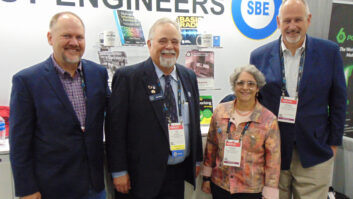
Sam Matheny, shown at the Empire State Building.The author is executive vice president and chief technology officer of the National Association of Broadcasters and a member of the National Wireless Safety Alliance Board of Governors.
Most of us in the broadcast industry work in offices or studios that provide a convenient and safe environment. These facilities are climate-controlled, well-lit and often come with amenities and security guards. We go about our jobs day-to-day with an expectation that we are basically safe in our work environment, and at some level are able to take workplace safety for granted.
This does not apply to our tower workers, though. For these people the safety risks are much more stark.
Tower workers perform their tasks outdoors where they are subject to the weather; heat and cold, wind and rain, ice and snow. They do this strapped to a tower at elevations as high as 2,000 feet while handling antennas that can weigh over 10 tons. Maneuvering, installing and maintaining this super-sized and cumbersome equipment is vital to the success of the broadcast industry, and safety can literally be the difference between life and death each day.

CONTEXT: SHORTAGE
To help assure the safety of tower workers and encourage high-quality tower work, the National Wireless Safety Alliance was formed.
The NWSA is a relatively new organization devoted to offering national assessment and certification programs for tower workers, filling a long time need in the wireless industry. NAB strongly supports this effort, and I will be serving on its board of governors. We look forward to contributing through this group to help assure the safety of those men and women who put and keep us on the air.
This is particularly important as we contemplate the completion of the incentive auction and the start of the spectrum repack.
The sheer volume of tall tower work could increase to unprecedented levels, with large numbers of tower climbs, antenna modifications and installations taking place under FCC-imposed time constraints. FCC simulations indicate that well over 1,000 stations could be required to make changes. And this isn’t just a television issue, as many FM radio station antennas are co-located on towers with television antennas.
All of this will be happening in the context of shortage. There are too few tower crews to handle the work in too short of a time frame.
NAB commissioned DTC to study and report on this issue and they found there are less than two dozen crews that meet the qualification criteria to remove and install heavy antennas (up to 24,000 pounds) and associated rigid transmission lines, as well as the capacity and willingness to work outside of their geographic regions.
This shortage means new crews will need to be trained in an attempt to meet demand. Having solid standards and a certification program can help ensure that safety remains the highest priority, and that the incentive auction and repack proceed unmarred by safety risks, poor quality of installations and above all, loss of life.
Keeping safety at the top of the checklist in this process is paramount.
Comment on this or any story to[email protected].












